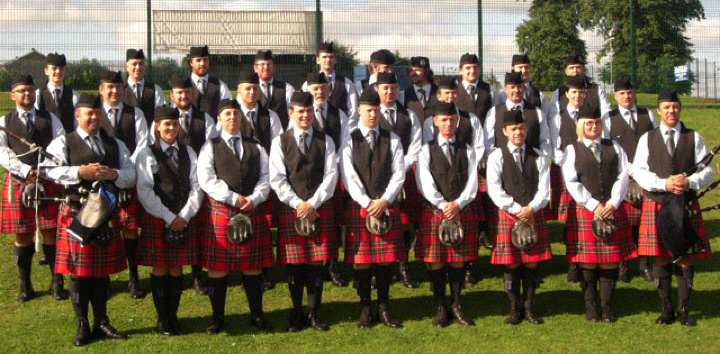
Ballycoan is a hamlet near the village of Purdysburn on the southern outskirts of Belfast. Despite its rural setting it supports both a flute band (formed in 1951) and a pipe band both of which are private organisations and, unusually, own their own band halls.
Aside from the Field Marshal Montgomery Pipe Band, which was formed just half a dozen miles further up the road outside Carryduff, the Ballycoan Pipe Band is the second most successful outfit in Northern Ireland. The band is pictured above in 2010 under P/M Alfie Rea.
Throughout its first period of success in the 1950s and 1960s it revelled in the nicknames of ‘The Coan’ or, due to its Royal Stewart tartan, ‘The Red Devils’. In an outline history published on its Facebook page it states that ‘Ballycoan Pipe Band represents a tradition of musical skill that has bettered the best.
‘The Coan’s history belongs to men and women of determination, forming it from the ashes of a post First World War Pipe Band, injecting new life into the Royal Stewart Tartan in the aftermath of the Second World War, and eventually taking it into a new millennium.’
While this outline is undoubtedly true, it does not reflect the fact that the band has experienced many ups and downs. However, unlike so many others it managed to rise from the ashes to even higher standards – and hopefully it can do the same again.
The birth of the dates back to 1935 when Pipe Major William Evans and Pipe Sergeant Willie John Gregory of the Coronation Pipe Band decided it was time to start a pipe band in the village of Ballycoan.
In a short time the new band was launched as ‘Ballycoan Jubilee Pipe Band’, the ‘Jubilee’ being added as 1935 was the Silver Jubilee of King George V. Fund raising was high on the first committee’s agenda with a Bazaar and Sale of Work being held at Ballycoan Orange Hall in 1936 to raise funds for instruments and their own band hall. In the 1950s in particular, regular dances including one each New Year’s Eve, would be held to support band funds.
The band hall problem was resolved by the purchase of an old hut located on a site on the Laganbank Road, Belfast. The hut cost £40 and was dismantled and re-erected on land given to the band by a Mr John Wilgar.
Ballycoan eventually made it onto parade around 1937 in uniforms purchased at the cost of £400 with William Evans as the first Pipe Major. Two years later the Second World War broke out and, like so many other bands, the Coan closed down for its duration. After the Belfast air raids of April 1941 the band hall was taken over to house refugees from the city.
Post war competitions
While Ballycoan were not undertaking any engagements during wartime, it would seem that some planning looking toward to the future had taken place and specifically one that involved competition. In July 1943 the band’s Chairman, Dick McBride, approached William Wood from Dromara Highland to become both tutor and Pipe Major. It is recorded that around this time the band also purchased a new set of pipes.
The first record of them competing was at a North of Ireland Bands Association (NIBA) Band and Quartet competition held in March 1944 at the Clarence Place Hall, Belfast, when they took fourth place.
In June 1944 they were placed fourth in the Junior Section at the Mid Down Contest Committee event in Dromara. In July 1944 Belfast Corporation held a contest at Windsor Park as part of their ‘Holiday at Home’ programme when the band took second place behind Dromara with leading bands of the era Sydenham and East Belfast placed third and fourth.
This result would appear to have led to them being placed in the Intermediate Section when they competed at the Mid Down event in 1945 and were placed fourth. They competed again in July 1945 at another Belfast Corporation sponsored event held at the Ravenhill Rugby Grounds when they were placed fourth. At the close of that same year the NIBA held a ‘Victory’ contest in which the band took second place in the Junior grade. Ballycoan were here to stay.
- To be continued.